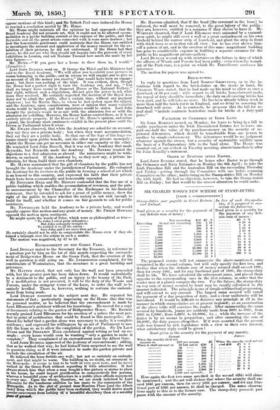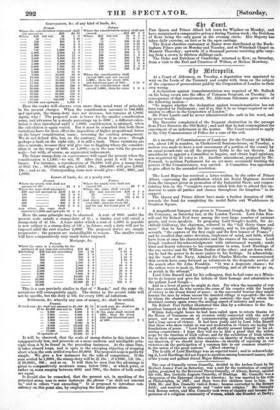Stanip-elatiee noir payabk in Great Britain and Ireland.
Bond given as a security for the payment of any definite sum of money :
Is lieu of such. Stanip-da- ties, it or poescd to con- stitute the following.
Bond given as a security for the payment of any defi- nite sum of money :
Not exceeding £50 £1
0 BO 5 0 Exceeding 50 and not exceeding 100 100 1 10 0 10 0 200 2
1 0 0
200 300 3 0 • 1 10 0
300 500 4
0
2 10 '0
500 1,000 5 0 5 0
0-
1,000 2,000 6 0 10 0 0.
2,000 6,4700 3,000 7 .0 15 0 0
4,000 8 0 20
0
0
5,000 9 0 25 0 0
4,000 10,000 12
50 0 0 5,000 15,000 15
0•
/5 0
10,000 15,000 20,000 20 0
100 0 0
20.000
25 0
The proposed statute will not enumerate the above-mentioned sums comprised in the second column, but will only specify the float two, and declare that when the definite sum of money secured shall exceed 1001., then for every 1001., and for any fractional part of 1001., the stamp-duty shall be 108. We have calculated the subsequent sums, and placed them opposite to the corresponding ones in the first tolumn, in order that the reader may at a glance compare the two. For the fliture the stamp-duty on any sum of money secured by bond may be readily gilculated in the manner indicated. The principle is one of simple arithmetical progression, and will extend to any amount. The largest sums secured will entail the payment of a due proportion of duty, and a clear uniformity will be introduced. It would be difficult to discover- any principle at all in the manner in which stamp-duties are at present imposed; as an examination of the above table will convince the reader. After orninsemttig the sums secured by hundreds, jumps are suddenly made from 800/..to 5001., from 500/. to 1,000?., from 5,0001. to 10,000/., dm. • while the increase of the duties is by no means in proportion; and after exceeding the sum of 20,0001., the duty pauses altogether. If it were asserted that the present scale was framed by rich legislators with a view to their own interest, what satisfactory reply could be given ?
Bond given as the security for the payment of any annuity.
Present.
When the annuityshall not
amount to £10 per annum When it shall amount to 10 but not
50 to 4150 100 100 — 200 200 300 300 400 400 SOO 500 — 750 750 — 1,000 — 1,000 1,500 1,500 MOO
Here again the first two anise specified iii the -second tilde will alone be mentioned ; and the act will declare that where the annuity shall ex, ceed 1001. per annum, then for every 1001. per minim, URI for any frac- tional part of 100/. per annum, 21. shall be charged. The same observa- tions apply to this as to the former case. The stamp-duty proceeds pari passu with the amount of the annuity.
2,000 and upwards..
al
Fatuir.
When the annuity shall not ex=
2
cm! Lib° £1 0 0
3 . 2 0 0 4
4 0 0 5
6 0 0
4
8 0 0 7
10 0 0 9
12 15
• • • ...... . 20 .36 0 0 o a
20 40 0 0 25
Conveyances, &o. of any kind of lands, &c.
Present. Picture.
Where the consideration expressed shall Where the consideration money shall not not amount to £0 1 exceed £25 SO 2
Where £20 but not 50 1 Where £25 but not 50 0 5
50 - 150 1 I - 50 - 75 0 7
- 150 - 300 2 - 75 - 100 0 10 -- 300 - 500 3 --- 100 - 125 0 12 -- 500 - 750 6 - 125 - 150 0 15 - 750 - 1.000 9 - 150 - 175 0 17
1,000 - 2,000 12 - 175 - 200 1 0 2,000 -- 3.000 25 - 200 - 250 1 5
3,000 - 4,000 35 - 250 - 300 1 10 4,000 - 5,000 45 - 300 - 350 1 15
5,000 - 6,000 55 - 350 - 400 2 0
8,000 - 7,000 65 - 400 -- 450 2 5
7,000 - 8,000 75 - 450 -- 500 2 10
9,000 85
10,000 95 Where the consideration shall
12,500 110 exceed 5001. and not exceed 12,500 - 15,000 130 1,0001., then for every 1001. 15,000 - 20,000 170 and fractional part of 100/... 0 15 0 20,000 - 30,000 240 Where the consideration shall 30,000 - 40,000 350 exceed 1,0001., then for same 1 0 0 40,000 - 50,000 450 50,000 - 60,000 550 60,000 - 80,000 650
- 80,000 - 100,000 800 - 100,000 and upwards ... 1,000
Here the reader will observe even more than usual want of principle in the present charges. When the consideration amounts to 100,0001. and upwards, the stamp-duty does not increase, but remains at 1,0001. Again, why ? The proposed scale is lower for the smaller consideration sums, and advances by a steady percentage up to 5001. ; a different calcu- lation is then introduced until a 1,0001. consideration is attained, when the calculation is again varied. But it must be remarked that both these variations have for their effect the imposition of higher proportional duties an the larger consideration sums ; reversing the existing arrangement. We do not defend this, but, on the contrary, deem it an error : though perhaps a fault on the right side, it is still a fault. Three variations are also a mistake, because they will give rise to higgling where the consider- ation is on the verge of 5001. or 1,0001.-as is the case with the present scale-but with, of course, an augmented inducement. The future stamp-duty on conveyances will equal the present when the consideration is 1,1501.-to wit, 91. After that point it will be much larger. For instance, a consideration of 79,950/. will give a stamp-duty of 8021. 10.8. ; 99,9501. will give 1,0021. 108. ; 200,000/. will give 2,0021. 108. and so on. Corresponding sums now would give-6501., 8001., and 1,0004
Present.
Where the yearly rent shall not
Future.
Where the yearly rent shall not amount to 201
£1 0 0
exceed 251.
£0 2 6
Where the same shall amount to
Where the same shall exceed
£20 and not amount to £100
200 1 10 0
S25 and not exceed £50
50 75 0 5 0 2 0 0 0 7 6 100 200 400 75 100 3 0 0 0 10 0 400 600
And where the same shall ex-
4 0 0
600 800 5 0 0
teed 1001., then for every 501.,
800 1,000 6 0 0
and for any fractional part of
And where the same shall
501. 0 5 0
amount to 1,0001. and upwards 10 0
0
Here the same principle may be observed. A rent of 9991. under the present scale entails a stamp-duty of 6/. ; a similar rent will entail a stamp-duty of 41. 16s. A lease under which a rent of 1,000/. is payable is now subject to a stamp-duty of 10/. ; in future, such a duty will not be imposed until the lent reaches 2,0001. The proposed duties are simply progressive ; the present are unintelligible to reason. The smaller rents
will have comparatively very small duties imposed.
Mortgage, &c.
Present.
Where the same is a security for the Future.
payment of any sum not exceeding 250
£1 £0 5
Exceeding 250 but not exceeding 100
100 200 1 1 0 10 2 1 0 200 300 3 1 10 300 500 4 2 10 500 1,000 5 5 0 1,000 2,000 6 10 0 2,000 3,000 7 15 0
3,000 4,000 8 20 0 4,000 5,000 9 25 0 5,000 10,000 12 50 0 10,000 15,000 15 75 0 15.000 20,000 20 100 0 20,000 25
This is a case precisely to/miler to that of ' Bonds," and the same ob- servations will consequently apply. The duties in the second table will not be specific, but the duty is 10s. for every 1001. ad infinitum.
Settlement, &e. whereby any sum of in
Present.
ney, &c. shall be settled.
Future.
If such sum, &c. shall not amount to £1,000
41 1 If such sum, &c. shall not
If to £1,000 and not to - 2,000 2,000 2 exceed 1001. £0 5 3,000 3 If the same shall exceed
4,000 4 1001., then for every
4,000 - 5,000 5 1001. and fractional part
- 5,000 7,000 7 of 1001
0 5
- 7,000 9,000 9
- 9,000 12,000 12
12,000
-
15,
- 15,000 -- 20,000 20
If upwards of 20,000 25
It will be observed, that the scale of stamp-duties in this instance is comparatively low' and proceeds on a more uniform and intelligible prin- -ciple than is to be found in the preceding instances. At the same time, it takes absurd leaps, and is open to the sweeping objection of stopping short when the sum settled reaches 20,000!. The proposed scale is perfectly simple. We give a few instances for the sake of comparison. If the sum settled be 1,0001., the stamp-duty will be 21.10s.; if 5,0001., 121. 108. ; if 20,000L, 501.• and so on. It will then be seen that the advantage is given to comparatively moderate sums, below 7001. ; at which point, or rather on sums ranging between 6001. and 7001., the duties of both scales are equal. It should also be remarked, that the present alt., in speaking of the principal sums, uses in some instances the phrase "as shall not amount to," and in others "not exceeding." It is proposed to introduce con- sistency on this point also, by employing the latter phrase alone.
8,000 -
9,000 -
10,000 -
Leases of lands, &e. at a yearly rent.



























 Previous page
Previous page